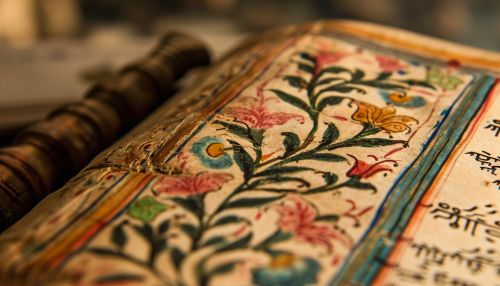Sanskrit literature
Origins and Development
Sanskrit literature, one of the richest literary traditions of the world, has its roots in the ancient Indian subcontinent. The earliest form of this literature is the Vedic corpus, composed between 1500 and 500 BCE. This corpus includes the Rig Veda, the Sama Veda, the Yajur Veda, and the Atharva Veda, which are considered the foundational texts of Hinduism.


The Vedic texts were followed by the Brahmanas, Aranyakas, and Upanishads, which are collectively known as the Vedanta. These texts, composed between 800 and 200 BCE, represent a shift from ritualistic practices to philosophical speculation.
The Mahabharata and the Ramayana, two of the world's longest epic poems, were composed in Sanskrit during the first millennium BCE. These epics, along with the Puranas, form the Itihasa tradition of Sanskrit literature, which narrates the history and mythology of ancient India.
Classical Sanskrit Literature
The period from the 4th century BCE to the 4th century CE is considered the classical period of Sanskrit literature. This period saw the composition of the Natya Shastra, the world's oldest surviving treatise on dramatic theory, and the Kamasutra, a treatise on love and sexuality.
The classical period also saw the rise of Kavya poetry, characterized by its intricate style and sophisticated use of metaphor. The greatest exponent of this tradition was Kalidasa, often hailed as the Shakespeare of India. His works, such as Abhijnanasakuntalam, Meghaduta, and Raghuvamsa, are considered masterpieces of world literature.


Scientific and Philosophical Literature
Sanskrit literature is not limited to religious and poetic texts. It also encompasses a vast body of scientific and philosophical literature. The Sushruta Samhita and the Charaka Samhita, composed between the 1st and 6th centuries CE, are foundational texts of Ayurveda, the traditional Indian system of medicine.
The Brahma Sutras, the Yoga Sutras of Patanjali, and the Vedanta Sutras are key texts of Indian philosophy, dealing with topics such as metaphysics, epistemology, and ethics. The Arthashastra, a treatise on statecraft and economic policy, is another significant work of this period.
Decline and Revival
The decline of Sanskrit literature began in the medieval period, with the advent of regional languages and the Islamic conquest of India. However, Sanskrit continued to be used as a language of scholarship and religion.
In the modern period, there has been a revival of interest in Sanskrit literature, both in India and abroad. Scholars have translated many Sanskrit texts into other languages, and there are ongoing efforts to preserve and promote this rich literary tradition.
